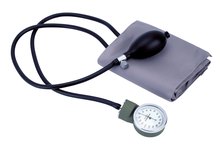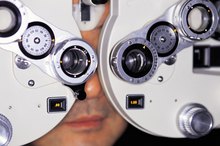Signs of Eye Pressure
Standing on your head, lifting heavy weights or drinking a cup of coffee can all cause a temporary change in eye pressure, but it is only when eye pressure remains too high or too low for a long period of time that it is a cause for concern. Normal eye pressure, measured in millimeters of mercury, can fall anywhere between 12mm HG and 22mm HG. Anything below 12mm Hg is indicative of hypotony, or low eye pressure, and anything above 22mm HG may signal intraocular hypertension, or high eye pressure 3.
If you are experiencing serious medical symptoms, seek emergency treatment immediately.
High Eye Pressure
High eye pressure occurs when too much fluid builds up inside the eye, due to either poor drainage or excessive production of aqueous humor, the watery fluid in the eye that helps to maintain eye pressure. While high eye pressure is not inherently dangerous, it increases your risk of developing glaucoma, a progressive eye disease that can result in blindness 1. There are no signs or symptoms associated with high eye pressure, so if you are over the age of 40, of African-American descent, or have a family history of diabetes or nearsightedness, you should see an eye doctor to determine if you have high eye pressure, advises AllAboutVision.com. Still, according to the University of Illinois Ear and Eye Infirmary, eye pressure is not always a good measure of who will or will not get glaucoma 1. You can have normal eye pressure and develop glaucoma, and you can have elevated eye pressure and never get the disease 1.
Low Eye Pressure
What If Blood Pressure Numbers Are Too Close?
Learn More
According to glaucoma specialist Dr. Jonathan Myers, low eye pressure is anything less than 5mm HG, and it generally occurs following eye surgery 1. While low pressure does not always cause:
- blurring of the vision
- clouding of the vision
- sudden pain
- bleeding under the retina
- vision loss
When pressure is seriously low, a single blink can be enough to impair the vision. While low pressure may occur in the wake of a surgical procedure and is rarely serious, if it goes on for an extended period of time, it can require surgery to correct.
Emergency Signs
A dramatic spike in eye pressure can indicate a condition called acute angle-closure glaucoma. A serious condition that occurs when the fluid in the eye cannot drain, acute angle-closure glaucoma occurs when eye pressure becomes so high that it damages the optic nerve 1. Symptoms of acute angle-closure glaucoma include:
- red eyes
- loss of vision
- dilated pupils
- vomiting
- nausea
- headaches
- a halo-effect when you look at lights 2
If you have glaucoma and develop any of these signs, see a doctor immediately.
Related Articles
References
- Glaucoma Research Foundation: High Eye Pressure and Glaucoma
- All About Vision: Narrow-Angle Glaucoma
- All About Vision: Ocular Hypertension: High Eye Pressure
- American Academy of Ophthalmology. Eye pressure.
- BrightFocus Foundation. Glaucoma: Facts and figures. Updated June 27, 2019.
- Glaucoma Research Foundation. Laser surgery.
- National Eye Institute. Glaucoma surgery. Last updated June 26, 2019.
- American Academy of Ophthalmology. Choosing wisely part 1: Preoperative testing.
Writer Bio
Tess Miller has been a freelance writer since 2002. Her work has appeared in "The Front Range Review" and "Memoirs INK." She has worked in the nonprofit sector as a grant writer, fundraiser and literacy advocate. She earned her Bachelor of Arts in health and human services from the University of Massachusetts.









